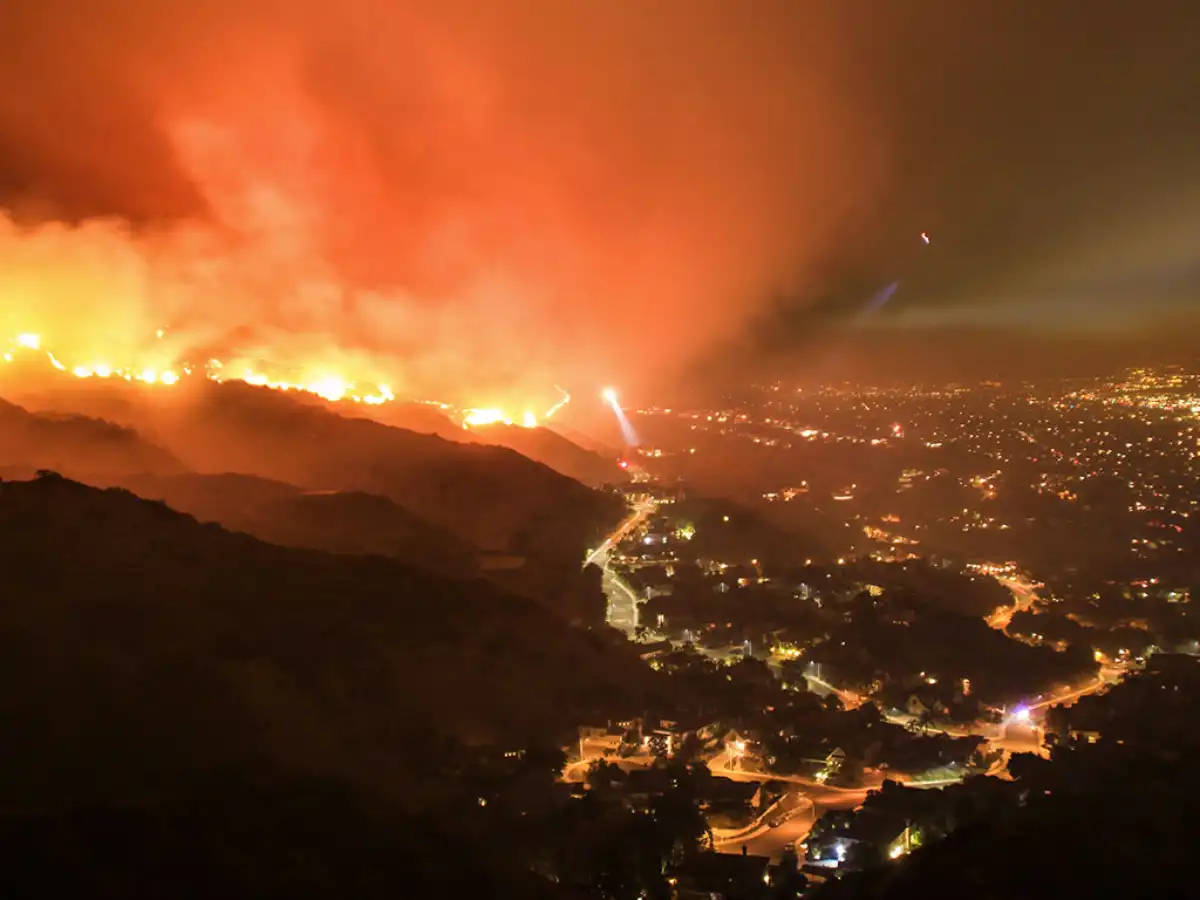On average, more than 100,000 wildfires clear 4 million to 5 million acres of land in the United States every year and result in annual federal suppression costs typically ranging from $1 billion to $2 billion, according to the National Inter-agency Fire Center. Wildfires are increasing in severity, frequency and duration, largely due to longer wildfire seasons caused by hotter and dryer weather, earlier melting of winter snowpacks and changing meteorological patterns due to climate change. As a result, business owners must take precautions to minimize property loss and damage.
Although wildfires can occur at any time throughout the year, they’re most common between April and October when there is little to no rainfall and grass, brush and trees are very dry and ignite easily. Significant portions of the United States are at risk of experiencing the effects of wildfires, particularly in the western and southern regions. An estimated 16% of the country’s population currently lives in wildfire-prone areas, according to the Washington Post, and that share is estimated to increase to 21% over the next 30 years.
While a business may not be able to reduce the risk of a wildfire occurring in its area, there are measures it can take to protect property and employees. This guide provides recommendations for actions to take before, during and after a wildfire so businesses can reduce the potential for catastrophic loss and get back up and running as quickly as possible.
How Wildfires Spread and Destroy Property
During a wildfire, property doesn’t have to take a direct hit from flames to be damaged or destroyed. Three ways wildfires can spread and impact property include:
Direct flames
Direct flames refer to an actual flame coming into direct contact with a building or other combustible material and igniting it.
Airborne embers
Embers are created from any piece of burning or smoldering material and can be carried long distances by wind. Embers are one of the top causes of building ignitions due to wildfires, as they can land directly on buildings, nearby plants or other combustible materials.
Radiant heat
Radiant heat refers to heat that is transferred from one fuel source to another without contact between the two sources. In other words, if the combustible material burning from a wildfire reaches a hot enough temperature, it can raise the temperature of other nearby material to the point of ignition.
Steps to Take Before a Wildfire
Include Wildfires as Part of a Business Continuity Plan
A business continuity plan outlines how businesses can restore critical operations during an unplanned disruption in service. However, studies have shown that more than half of all organizations worldwide do not have a business continuity plan in place. These businesses are at higher risk of reduced productivity, financial loss, reputational damage and business failure.
When creating a business continuity plan, it’s important to identify the most serious threats by focusing on the most likely disruptions and their potential impact. A business continuity plan should include:
- Business impact analysis—Businesses should recognize the types of events that could compromise operations, assess the severity of the threats, and identify steps to eliminate or minimize their impact.
- Recovery strategies—Following a disaster, a business must assess which critical functions are necessary for the restoration of sales, production and operations. Businesses can develop recovery strategies by identifying and documenting resource requirements, conducting gap analyses and exploring recovery strategy options.
- Plan development—By developing a plan framework, organizing recovery teams and developing relocation plans, businesses can ensure the proper steps are in place to keep property damage, business interruptions and bodily harm to a minimum.
- Testing and exercises—To successfully execute a business continuity plan in the face of disaster, it’s important to develop testing, exercise and maintenance requirements of the plan. In addition, training should be conducted, and an orientation process should be developed for new employees.
Review Insurance Coverage
Fire is a cause of loss typically covered by most commercial property policies. Before catastrophe strikes, it’s important
to take the time to do a detailed insurance policy review to ensure the coverage is adequate. Considerations include:
- Policy limits—Are the building(s) and contents insured to value?
- Business interruptions—Is there coverage for a potential loss of income while the premises is unusable?
- Extra expenses—Is there coverage for any extra expenses incurred while operating the business out of a temporary location?
Protect Property
There are several steps businesses can take before a wildfire occurs that can protect property and reduce the chance of sustaining a significant loss. Such steps consist of the following:
- Create a defensible space around the property. Since wildfires rely on heat and embers moving between fuel
sources to spread, it’s essential to provide less fuel for the fire by creating cleared zones around the property.
According to the Insurance Institute for Business & Home Safety, the following are distinct buffer zones that
make it difficult for a fire to spread and reach the property:- Zone 1 (zero to 5 feet from the building)—This is the area immediately surrounding a building. Clear this zone of anything combustible, including flammable species of plants, sticks, leaves and any other debris that might collect around the building. This zone should also be designed using noncombustible materials, such as gravel or rocks.
- Zone 2 (5-30 feet from the building)—In this zone, space trees at Least 10 feet apart and prune limbs to a minimum of 6 feet off the ground. Fallen debris such as branches, leaves and needles should be regularly removed to prevent the fire from spreading. Additionally, structures utilized by the business, such as sheds and storage buildings, should be at a minimum of 30 feet from the main building.
- Zone 3 (30-100 feet or more from the building)—This is the building's first line of defense. The purpose of Zone 3 is to create an environment in which wildfires will have trouble spreading. Like Zone 2, it's important to prune trees regularly and clear any dead trees and plant debris from the area to make it difficult for fire to jump from one tree to the next.
- Install Class A-rated roofing. Class A-rated roofing—such as concrete or clay roof tiles, fiberglass asphalt composition shingles or metal roofs—has been proven to provide the most effective fire protection in severe fire test exposures.
- Reduce vegetative fuel around the building. By creating a vegetative maintenance plan, businesses can reduce ignition sources close to their property. They should select plants with low combustibility characteristics—high moisture content, low oil or resin content, deep roots with thick heavy leaves, and minimal production of dead vegetation—to be planted closest to the building. They should also prune trees and shrubs, remove brush, control weeds and remove dangerous trees near structures and powerlines.
- Check fire hydrants and water supplies. Fire hydrants should be no more than 250 feet from primary buildings and connected to a reliable public or private water source. Businesses should contact their local fire department to help with testing and maintaining the fire hydrant. If located in an area without fire hydrants, businesses should consider maintaining a water supply that can control small fires until emergency personnel can arrive. This may include installing a water tank or hoses and pumps to an existing swimming pool, pond, river or lake. In addition, water outlets and pumps should be properly insulated if a business is in an area subject to freezing temperatures. Lastly, if a water pump uses electrical power, a gasoline- or diesel-powered generator may be necessary in case electricity is cut off during a wildfire.
- Use fire-resistant, noncombustible building materials. To decrease the risk of property damage, signage, exterior walls, fences, walkways, decks, roofing, gutters and stairs should all be constructed out of fire-resistant, noncombustible materials such as steel, masonry, ceramics and fiberglass.
- Upgrade windows. Double-paned windows with tempered glass can offer increased protection against radiant heat.
- Clean off the roof and gutters. To minimize the risk of ignition, the property’s roof and gutters should be cleared of all debris, such as pine needles and leaves. This maintenance should be done at the change of the seasons and after storms.
- Cover vents with mesh screens. Airborne embers can get into a building through the vents. Therefore, vents should be equipped with a one-half-inch mesh screen. Accumulated debris must be removed from vent screens to limit the combustible material that can ignite.
- Take photos and videos of interior and exterior assets. Taking photos or videos of the interior and exterior of the building prior to any wildfire damage can help jump start the insurance claims process.
- Back up data. Lost data can slow down the process of getting a business back up and running. To minimize the loss of data following a wildfire, data should be backed up to the cloud and on an off-site drive.
Protect People
In addition to protecting property, it’s important that businesses take steps to protect their people. Since wildfires can spread quickly, advanced planning and preparation can help reduce the chance of experiencing injuries and even loss of life. The following actions can be taken to protect employees and others in the event of a wildfire:
Create a wildfire evacuation plan
Businesses must establish a wildfire evacuation plan, keep it up to date and hold evacuation drills regularly so employees are familiar with
the routes. There should be at Least two routes planned, and employers should consider how to evacuate on foot if roads are closed or impossible to use.
Review and distribute an employee communication plan
A communication plan should be Long before it's needed by keeping employee records updated, establishing a mass notification system and setting guidelines for reaching out to anyone at risk.
Keep fire extinguishers in strategic locations and train employees on how to use them correctly
Employees must be trained in general fire safety, including when and how to use fire extinguishers. Employers should ensure there are an adequate number of fire extinguishers that are properly maintained.
Ensure emergency listings are up-to-date
Employers should keep adequate contact information for Local fire and police departments, hospitals, water and gas companies, as well as the business' insurance company.
Create and maintain a supply list
The business should be equipped with battery-operated handheld radios, flashlights, additional chargers and batteries, water, food and first-aid supplies.
Steps to Take During a Wildfire
In the event of a wildfire, employers should follow these steps to reduce damage and keep employees safe:
- Keep track of updates. Closely follow alerts in the area from federal alert systems, local or state wildfire websites, and threat intelligence systems.
- Be prepared to put the business continuity plan into action. Businesses must make sure the business continuity plan is updated and communicated. It’s important to keep in mind that employees may need time to prepare their homes and attend to their families.
- Close windows, vents, doors and blinds. The fire’s reach can be limited by closing windows, vents, door and blinds.
- Shut off gas, pilot lights and propane tanks. Turning off the gas supply and other gas sources can prevent feeding the fire.
- Turn on all lights. Lights should be left on so firefighters can see the building under dark and smoky conditions.
- Shut off heating, ventilation and air conditioning (HVAC) systems. HVAC systems should be turned off to prevent outside smoke from entering the building and causing preventable damage.
- Move flammable items inside. Pallets, tables, chairs, benches, outdoor equipment, signage, inventory and other loose items must be moved inside.
- Follow evacuation warnings. Evacuation must take place as soon as it is deemed unsafe to stay; employees and others must not wait to receive an emergency notification if threatened by a fire. Otherwise, they should be prepared to follow evacuation warnings from local officials. Employees should be sure to take a safety kit and lock up the property. If unable to evacuate, people should stay inside, away from outside walls, and leave doors unlocked in case firefighters need to access the area.
Steps to Take After a Wildfire
Wildfires can still pose a serious threat even after the flames have subsided and cleanup efforts have begun. Without a strategic recovery plan in place, businesses may struggle to return to normal operations. The following steps can help rebuild a business following a wildfire:
- Maintain communications. Internal and external communications should be established with corporate management, insurance professionals, displaced personnel, customers, vendors, and local and federal government agencies.
- Return when safe and assess the damage. People should return to the site of the damage only after the proper local authorities have granted permission. When safe, those at the site must dress for recovery operations—heavy, thick-soled footwear; leather gloves; hard hat; safety glasses; safety vest; and mask—and take photos and videos of any damaged property.
- Check for other potential hazards. The site and building should be inspected for smoldering debris, live embers, heat pockets and ash pits. Other hazards include broken glass, sharp metal, weakened utility poles, trees and branches, live electrical wires, fuel gases or flammable liquids. Dead plants, trees or dry vegetation that could be ignited by flyaway embers must be removed.
- Make sure protection and mechanical systems are working. Qualified personnel should inspect all utility systems for damage before they are used since turning on compromised equipment can allow debris to be ingested into a building or generator engine, which could lead to damaging the system and contaminating the air with pollutants.
- Secure the area from future damage. Securing the area and checking for structural damage to the ceiling, roof, windows and doors can prevent more damage from occurring. Any dangers should be marked off with caution tape and areas must be sectioned off until their safety is determined.
- Assess flash-flood and mudslide risk. It’s vital to assess the risk for flash floods and mudslides in the terrain around and uphill from the property and take steps to limit damage. Since wildfires can burn a significant portion of vegetation that typically helps absorb excess water, heavy rainfall can result in an increased risk of runoff and flooding. In addition, burned vegetation releases organic compounds into the ground that, when combined with soil, creates a slick, waxy layer that repels water.
- Initiate repairs and salvage. Employers should establish priority repairs and begin salvaging the property. They should also consult with local experts to begin the restoration process.
- Contact an insurance company and an agent/broker. Businesses must consult with an insurance representative for information regarding filing claims and restoring their property. It may seem overwhelming to create a wildfire response plan, but fortunately, businesses don’t have to do it alone. To learn more about wildfire preparedness practices and specific policies available, working with a qualified insurance broker is essential. Contact us today to learn more.








